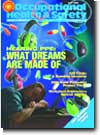
April 2006
- Hearing PPE: What Dreams Are Made Of
- Gift Cards: A Standout Incentive
- First Reponder: Pathogen Control
- Why One-Size-Fits-All Doesn't Work
Click here to subscribe.
Cover Story
By Linda F. Johnson, MS, CSP
YOUR hearing protection/conservation program is rolling along. Upper management is in full support. The budget is workable and approved, including audiometric testing, and engineering corrections (where possible) have been put into place. Your written program is great.
Features
By Barry R. Weissman
IT'S 2:30 in the afternoon and you are home in bed with a cold, sore throat, and runny nose, when the telephone rings. Your wife answers, then brings the phone to you. "It's your boss. There's a problem at work," she says.
By Larry Wilson
IN the quest to treat everybody fairly, quite often we forget the wisdom contained in the expression "different strokes for different folks." Although I have been on site to some 500 workplaces in Canada, the United States, Mexico, and Europe, I've never seen more than one set of rules and procedures--or, for that matter, more than one type of safety training program.
By Mary Beth Villalobos
IMAGINE being an employee in a workplace and going about your duties as you would on a daily basis . . . and an arc flash occurs. There is an explosive pressure wave and fire breaks out. Radiant heat is projected. Dangerous chemicals can be produced. And the damage is serious to fatal.
By James E. Jobes
MICHAEL White is the executive director responsible for apprenticeship and training for the Ironworkers union. He oversees numerous training programs for their members at a variety of locations, as well as classes at three permanent training centers the union maintains in New Jersey, Missouri, and California.
By Eric Jaeger
Safety professionals realize that high-dexterity gloves result in increased safety and job performance. Corporate managers know that increased safety reduces costs while increased performance enhances productivity, both of which boost the bottom line.
By Jerry Laws
Editor's note: Some ideas are so smart that you wish you'd thought of them yourself. Reused protective footwear, for example. If you haven't considered the possibility until now, Wayne Elsey, president of Kodiak-Terra USA, Inc. (www.kodiakterra.com) of Portland, Tenn., may make you a believer.
By Alan M. Wing, Ph.D.
GRIP is a safety issue in many industrial environments. During in-depth analyses conducted at more than a thousand workstations in more than 50 major manufacturing industries in Europe, grip in either wet or dry conditions was perceived as a need by workers at some 89 percent of the workstations.
By Judith Green-McKenzie, M.D., MPH, FACOEM, FACP, Garson Caruso, M.D., MPH
HOSPITAL-acquired (nosocomial) infections are estimated to occur in nearly 10 percent of all acute care hospitalizations. The estimated incidence is more than 2 million cases per year, resulting in an added expenditure in excess of $4.5 billion. Transmission of both normal and pathological microorganisms by the hands of health care workers (HCWs) is one of the main routes of infection spread. Skin microorganisms may be considered resident flora or transient flora.
By Stephen V. Magyar, Jr., MBA, CSP
MANY decisions to enter confined spaces are made without recognition of the expected danger. Lack of knowledge, carelessness, and simple acceptance of the hazard are the main reasons. The decisions to enter are made in spite of all efforts to provide hazard awareness and safety training.
By Josephine Elizabeth Kenney, J.D.
THERE has been a great deal of publicity, significant legislative activity, and recent case law on the authorized use of medical marijuana during the past few years that must be taken into consideration in workplace drug testing programs.
By Drew Bossen, PT, MBA
SITTING. It sounds simple enough. Yet despite years of training, training, and more training, the saga goes on. The saga "stars" the seated worker. Be it a call center employee, a manufacturer performing bench work, or an over-the-road truck driver, we continue to observe workers seated in semi-flexed, rounded postures.
Departments
By Jerry Laws
GENETIC screening done for occupational reasons is a potentially explosive issue. It burned Burlington Northern Santa Fe Corp., which agreed to pay $2.2 million three years ago to employees it had secretly tested. But we're seeing no headlines now: Is the issue settled? Hardly.